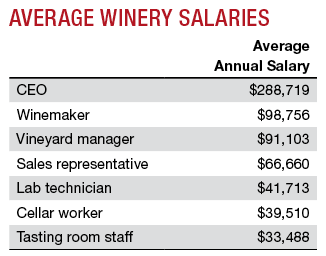Will Wage Hike Affect the Wine Industry?

Sacramento, Calif.—All businesses in California will be required to increase minimum wages, capping out at $15 per hour in 2022. On April 4, Gov. Jerry Brown signed legislation into law that will gradually raise the state’s minimum wage during a six-year period; small businesses with fewer than 25 employees may receive postponements.
The new structure will apply to all California businesses, not just agriculture. Napa Valley Vintners communications director Patsy McGaughy said that while the association has remained neutral on the issue, most Napa Valley wineries already pay workers at the elevated level.
She added, however, “When you raise the wage floor it has an effect all the way up the ladder. In Napa, most of the work done here for pruning and harvest is done by hand, and we already pay those wages.”
McGaughy noted that 95% of NVV member wineries are family owned, and fewer than 20% produce more than 10,000 cases annually.
Brad Goehring, chairman of the state government affairs committee for the California Association of Winegrape Growers (CAWG), was on the Assembly floor March 31, when Senate Bill 3 was passed. The owner of 450 acres and manager for some 10,000 more in the Lodi District, Goehring told Wines & Vines he was texting key assemblymen with talking points during the debate.
He was not happy with the outcome of the vote, saying he foresees “destruction.”
“Grapes can be sourced elsewhere. This reverberates all the way down,” he said, adding that “hurtful” regulatory measures including Cal/OSHA rules have proliferated in recent years and are increasing pressures on the ag industry.
“We’re going to mechanize where we can,” Goehring said. With vineyard labor availability already short, “We’re going to have to swap labor for mechanization. Every commodity has its limits of elasticity.”
For example, Goehring said, “This winter I bought a berm sweeper for about $6,000. It will replace about 5% of my workforce. I will order leaf remover machines this week; each will replace a crew of 25 in a six-week period. More growers are using machine harvesting.”
The vineyard owner said he expects California growers to step up funding to fast-track research on vineyard machines. “We’ve outgrown the burden of labor,” the result of cost, productivity and regulation. He added that some wineries buying contracted grapes would have to give and take: Demanding hand harvesting, for instance, may soon be outdated.
CAWG doesn’t make recommendations, he said. “We look for solutions and educate” members. “Today on the floor, three assemblymen referred to ag wages as ‘slave labor.’” But this increase is not just about minimum wage. “It will raise prices for everyone and drive some business out of state. It will more than double the federal minimum wage.”
Earlier, CAWG president John Aguirre commented that skilled vineyard laborers already earn more than California’s current $10 per hour minimum. In the Lodi District, vineyard labor typically gets $11 to $12 per hour.
The new measure is, he said, “A very, very big deal. It affects all companies. There is a delay in the start date for smaller companies, but no blanket exemption.”
Representing a 50% increase in minimum wage, the law will not just affect entry-level workers but will go all the way up the chain, he said. If a different proposal, Assembly Bill 2757, should pass and be signed into law, it would eliminate the current agriculture overtime exemption, requiring ag business to conform with the prevailing overtime requirements that apply for most hourly paid jobs (i.e., the eight-hour day and 40-hour week thresholds would apply).
Aguirre compared California to Europe, where labor costs are high. “With less ability to lay off workers, companies are resistant to hiring, and there are stubbornly high unemployment rates,” he reported.
“I’m fearful of where we’re going. If this goes into effect, we’ll see big changes. There needs to be continual advances in mechanization, but only businesses of a certain size can afford it. Equipment can be too expensive. We’ll see small growers stay small while larger companies get larger. There will also be more reliance on farm labor companies,” he predicted. “It’s clear that $15 per hour will compel change.”
In an industry that prides itself on sustainability, “There are issues of social equity. Nobody knows where to draw a precise line between an exploitive starting wage and one that is appropriate for workers and employers,” Aguirre said. “When establishing a floor, it seems to us that $15 is too high.
“Potentially, this could do serious damage to the California economy and agriculture.”
Nat DiBuduo, president of Allied Grape Growers, also predicted an overall negative effect on agriculture. “Labor’s hard to come by, and the economic impact will make it more challenging for farmers. There will be (wage) increases all the way up the line,” he said, in a sort of reverse domino effect.
Of course, grape prices vary by growing area. DiBuduo pointed out that San Joaquin Valley growers may get $300 to $400 per ton vs. thousands per ton for North Coast or Central Coast grapes. In the San Joaquin Valey, 99% of vineyards are machine harvested, he said.
“If you already pay more than minimum wage to the entry-level employees, their supervisors will also expect more,” DiBuduo emphasized.
Moving the minimum wage won’t improve the labor supply, DiBuduo said. “When cherry harvest starts, there’s not enough labor for grapes. We see competing crops for the same labor force. What you’ve got is what you’ve got.”
|
|
PRINTER-FRIENDLY VERSION » |
|
|
E-MAIL THIS ARTICLE » |